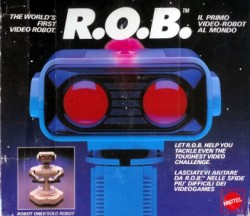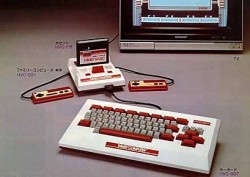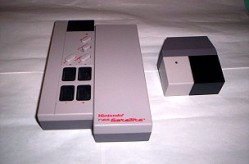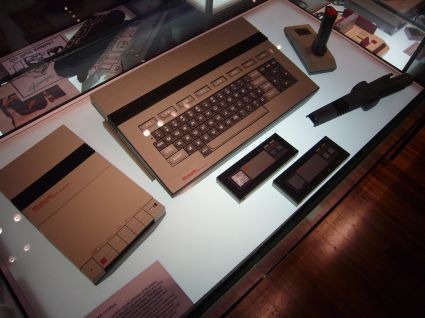In the summer of 1983, the original Famicom was unleashed on the Japanese market – a small, affordable home computer system with just three launch titles: Donkey Kong, Donkey Kong 2, and Popeye – each nearly dead ringers for their arcade counterparts. The console was an instant hit, and it wasn’t long before Nintendo started to look to the west, eventually releasing the legendary Nintendo Entertainment System in 1985 – but before the NES, Nintendo had something very different in mind, something that could been the difference between success and failure in the North American market. This is the story of the Nintendo “Advanced Video System”
After early success of the Famicom in Japan, Nintendo unsurprisingly turned to Atari, the US’s console king, to help them break into the western market. The two companies were in talks to create a Nintendo console under Atari’s popular name, with Nintendo providing hardware, software, and additional “Atari” titles for the Atari consoles. The deal for the Atari branded “Nintendo Advanced Video Gaming System” eventually fell through, but the North American Famicom project lived on. At CES in 1984 Nintendo showed the world it’s first attempt to reach the American market – the “Advanced Video System.”
Aside from sharing a similar color scheme, Nintendo’s “AVS” looked radically different than the final American console – it featured a built in keyboard, revolutionary gamepads, a joystick, a light gun, and a tape based storage unit – far more similar to “home computers” like the Commodore 64 than to Nintendo’s own Famicom. The AVS was impressive by 1984 standards – boasting unparalleled 8-bit graphics, and infrared wireless joysticks and game-pads. Despite this, Nintendo received no orders for the Advanced Video System – the US games industry was in the middle of the infamous 1983/84 crash and distributors weren’t interested in investing in the dying “video game fad.”
 Looking toward the Japanese parent company, Nintendo of America turned away from the “home computer” design and returned to CES in 1985 with a more traditional looking system (re-branded as the “Nintendo Entertainment System”) and a new gimmick – R.O.B., the Robotic Operating Buddy. Despite the attention Nintendo’s toy robot drew at the show, Nintendo again left CES without a distributor. Despite North America’s resistance to “another home video game,” Nintendo pushed on, determined to succeed. Following one more redesign that hid the cartridge, NOA pushed the NES into limited markets in New York and Los Angeles in October of 1985, promising to buy back any unsold units. The NES was marketed as a toy in attempt to distance it from negative associations with “home computers” and video games – and Nintendo’s gamble paid off – the test market exploded, and the rest is history.
Looking toward the Japanese parent company, Nintendo of America turned away from the “home computer” design and returned to CES in 1985 with a more traditional looking system (re-branded as the “Nintendo Entertainment System”) and a new gimmick – R.O.B., the Robotic Operating Buddy. Despite the attention Nintendo’s toy robot drew at the show, Nintendo again left CES without a distributor. Despite North America’s resistance to “another home video game,” Nintendo pushed on, determined to succeed. Following one more redesign that hid the cartridge, NOA pushed the NES into limited markets in New York and Los Angeles in October of 1985, promising to buy back any unsold units. The NES was marketed as a toy in attempt to distance it from negative associations with “home computers” and video games – and Nintendo’s gamble paid off – the test market exploded, and the rest is history.
History however, could have been very different. In the mid-eighties North America was seeing a backlash against home computer video games – the market was flooded with expensive consoles and countless poor quality games – while the NES and it’s “toy marketing” quickly rose above the “games crash” and lead a revitalization of the industry in North America, the AVS could have just been another failure in dying “home computers” market. Without Nintendo’s success as an example, Sega might never have attempted a NA release of the Sega Master System – and while gaming would have survived, the Japanese and Western markets may have remained separate until the 1990s or beyond.
 The success of the Nintendo Entertainment System changed things for the games market in North America, and while it’s fun to imagine a world where Nintendo stuck with the AVS design, we’re glad they didn’t. Still, the AVS’ components live on in separate products- A keyboard and BASIC based programming language called “Family Basic” were available in Japan, as well as a cassette data recorder. In North America, the prototype’s wireless capabilities survived through the NES Satellite – an infrared peripheral that connected controllers wirelessly as well as functioning as a 4-controller multitap. Despite the geeky novelty a “home computer” version of the NES might have been, complete with word
The success of the Nintendo Entertainment System changed things for the games market in North America, and while it’s fun to imagine a world where Nintendo stuck with the AVS design, we’re glad they didn’t. Still, the AVS’ components live on in separate products- A keyboard and BASIC based programming language called “Family Basic” were available in Japan, as well as a cassette data recorder. In North America, the prototype’s wireless capabilities survived through the NES Satellite – an infrared peripheral that connected controllers wirelessly as well as functioning as a 4-controller multitap. Despite the geeky novelty a “home computer” version of the NES might have been, complete with word  processors and home programming, data storage devices, and wireless connectivity, the market probably wouldn’t have accepted it. Infendo salutes the Nintendo Advanced Video System – thanks for being interesting, but for the sake of the early games industry in North America, we’re glad you’re dead.
processors and home programming, data storage devices, and wireless connectivity, the market probably wouldn’t have accepted it. Infendo salutes the Nintendo Advanced Video System – thanks for being interesting, but for the sake of the early games industry in North America, we’re glad you’re dead.
[Special thanks to NES World, Atari Museum, and Classic Gaming, for background information on the AVS]


